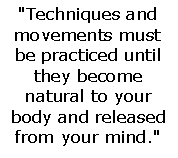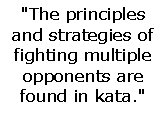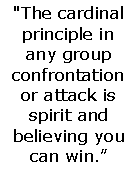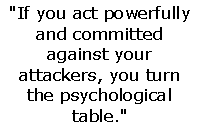Surviving A Multi-Opponent Attack
Part 2: Principles & Tactics
by Christopher Caile
Editor's note: This is the second of a series of articles
exploring principles, tactics and techniques that can be used when confronted
with multiple attackers.
A group attack is a chaotic nightmare of fear and danger -- a flurry
of fists and feet, sometimes weapons. You can be killed, or severely hurt.
To survive you have to be mentally prepared. You have to know how to take
control -- interrupt the attack, move and counter and create a whirlwind
of pain and confusion.
Different martial arts may have different emphases, approaches and sets
of techniques, but at their root they share many common principles of
movement and strategy which are discussed here.  These
apply not only to one-on-one situations, but if abstracted to a larger
context, they can also be applied to fighting multi-opponents. These
apply not only to one-on-one situations, but if abstracted to a larger
context, they can also be applied to fighting multi-opponents.
While far from complete, below I have tried to summarize some hard lessons
learned over a lifetime. As just words and ideas they are of little value.
To make them work you must train. Techniques and movement must be practiced
until they become natural to your body and released from the mind.
When in graduate school in Washington DC in the late 1960s, I practiced
karate in a sort of community dojo shared by other teachers from a number
of styles. Most of us were there to continue our own training rather than
to teach beginners. In the group were several police officers, and we
soon found ourselves practicing numerous scenarios defending against various
group attacks, with and without weapons. Interestingly it was at this
time that I began to explore and analyze my karate kata (a mix of Shotokan
and Goju-ryu) for applications, strategy and principles. I still remember
being struck by the similarities between the two, and how much the principles
and strategies of fighting multiple opponents are found in kata.
 While
this article focuses on particular principles and tactics used in multi-opponent
attacks, if you are a karate, taekowndo or kung fu student, look to your
kata too. With study you will begin to understand how traditional kata
work as a method of transmission for many of the same ideas: spirit, commitment,
quick flurries of technique, pivoting and change in direction, control,
or throws of an opponent and many other strategies. While
this article focuses on particular principles and tactics used in multi-opponent
attacks, if you are a karate, taekowndo or kung fu student, look to your
kata too. With study you will begin to understand how traditional kata
work as a method of transmission for many of the same ideas: spirit, commitment,
quick flurries of technique, pivoting and change in direction, control,
or throws of an opponent and many other strategies.
Many readers are already competent martial artists and competitors. But
two person practice fighting is very different and actually often counterproductive
in a group confrontation. If you try to use the lessons of one-on-one
competition learned in karate, taekwondo or kung fu, you might get lucky,
but more probably you will get hurt, possibly very hurt. You must practice
in situations where attackers don't take their turn, and where you are
faced with attacks from multiple sides.
How you react and move depends, of course, also on the environment and
space available. Obviously, if you are in an elevator, entrance way, on
stairs or in some other limited space area, you will react very differently
than in a wide open area. Also, don't expect not to get hit. You can move
way from many attacks, duck under others, block, or jam, but you will
undoubtedly get hit. Learn how to absorb blows by either moving with the
technique or rolling off them. Also, learn how to take a punch.
Indomitable Spirit
The cardinal principle in any group confrontation or attack is spirit
and believing you can win. Without indomitable spirit, the belief you
will win or escape unhurt, you are psychologically bound -- so tied up
in fear, worry, insecurity, etc. that you will defeat yourself.
Most great martial artists of the past exhibited this trait, Aikido's
Morihei Usehiba, Judo's Jigoro Kano, Daito-Ryu's Sokaku Takda and Kenjutsu
(sword arts), Miyamoto Musashi. The list is endless.
Kaicho Tadashi Nakamura (founder of World Seido Karate) often talks about
this -- how spirit should permeate every movement, even the eyes.  You
can see it in his kata, how he moves with liquid power, tiger-like ferocity
mixed with the fluid grace of a dancer. He exhibits more than anyone I
know how kata can be used to train indomitable spirit and power. You
can see it in his kata, how he moves with liquid power, tiger-like ferocity
mixed with the fluid grace of a dancer. He exhibits more than anyone I
know how kata can be used to train indomitable spirit and power.
Indomitable spirit can both deter an attack and sustain you in battle.
There are numerous tales in Japanese folklore about its magic. There is
no greater example than the 16th century Japanese swordsman, Miyamoto
Musashi, who was undefeated in over 60 sword contests. His indomitable
spirit permeated every aspect of his person -- the way he walked, stepped
and even how he rode a horse. It was so strong that to many it took almost
a physical form, something instantly recognizable. For many would-be challengers,
just the sight of him made them faint of heart.
Killing With One Punch
There is an old karate maxim that states, "To kill with one punch."
Although interpretations vary, the end result is that in action you should
put everything into your techniques. The bottom line is that you must
be fully committed in your actions.
Against multiple opponents, your movements must come dramatically and
powerfully, without hesitation. There is no time for hesitation, faking
or trying to figure out or watch what all attackers are doing. In karate,
taekwondo or kung fu, this might be a great strategy for deciphering an
opponent's reactions or tendencies in a one-on-one situation. But with
multiple opponents if you hesitate they will close around you like the
jaws of the shark. Too late. So, don't waste time. Every second you lose,
your opponents gain.
 Remember
too, that attackers also are scared. They count on intimidating you and
mentally dominating the situation with fear. Often an initial push is
used to off balance or disorient you, or an initial attack is used to
stun and immobilize. Instead, if you act powerfully and committed against
your attackers, you turn the psychological table. They start thinking
and questioning their actions. See my article "'Yoi' & The First
Preparatory Moves Of Kata" currently on the Magazine page of this
site. Remember
too, that attackers also are scared. They count on intimidating you and
mentally dominating the situation with fear. Often an initial push is
used to off balance or disorient you, or an initial attack is used to
stun and immobilize. Instead, if you act powerfully and committed against
your attackers, you turn the psychological table. They start thinking
and questioning their actions. See my article "'Yoi' & The First
Preparatory Moves Of Kata" currently on the Magazine page of this
site.
I am always struck by how some people while practicing (karate, taekowndo
and kung fu) free fighting score phantom points by faintly reaching out
to touch an opponent. Judges in a contest may award a point, but on the
street such tactics will only draw smiles, or worse get you really hurt.
Use Whatever Is Available
If you are in a room with lots of furniture, tables, chairs, bar stools,
etc., use them to your advantage. If you are outside, the same can be
said for cars, trees, shrubs, etc. If it can be picked up, throw it, use
it as a barrier, a whip, or a weapon. If it can be moved, position it
in your favor. If it is fixed, maneuver yourself. A fixed object can block
others, protect your back, or protect you from thrown objects, even gun
fire. If you have no improvised weapons or no time to prepare, you can
always shout, kiai, or spit in an attacker's face to distract them. And,
if there is time, get an attacker to talk -- by making him think, you
have slowed his reactions. You have also bought yourself precious seconds.
Become Unpredictable & Disruptive
No great master, sifu or teacher can ever predict how a group attack
will unfold. In a group confrontation, chaos and unpredictability reign
supreme.
-
Become unpredictable yourself, so you don't become an easy target,
and so you can disrupt others as you shift, change direction and move.
Kick out in one direction while you punch in another. Become a flurry
of committed mayhem -- in all directions.
-
Don't stay focused in one direction or on one opponent too long.
At most, you have a second, maybe a second and one half to deal with
any one attacker. Get is over wiyh fast, and as in karate kata, change
direction and move.
-
Use short flurries of close in techniques, and keep low and balanced.
Avoid long, stretched out kicks or punches that waste time and can
leave you hanging and vulnerable.
-
Keep your weight distributed on both feet so you can move easily
in any direction. If you plant your weight on one foot, or lift it
waiting to kick, or a leg or knee to block, you are momentarily immobile
and unbalanced.
-
Be aware of what is happening around you. This is not practice freefighting
against a single opponent. This is different. It involves all 360
degrees around you and multiple opponents.
Severing The Head Of The Serpent
In a group confrontation, if you can first disable or hurt the leader,
or at least the first person who attacks, you can sometimes end the confrontation
before it fully develops. It's like severing the head of a serpent. The
rest of the body may wiggle, but it won't hurt you.
Disabling the leader is also a psychological strategy. It creates doubt
among the others. You are showing he can't lead or protect them.
If surrounded on two sides and the front and you don't know who the leader
is, deal with the first attacker, or become preemptive and move to deal
with an attacker on one side. This will be discussed in detail in the
following article.
Use Your New Friends
It's sometimes better initially to cause pain and leave attackers standing
than to knock them out. The person you have just hurt can become a potent
psychological weapon. His screams or shouts of pain can act as a deterrent.
Seeing a buddy hurt, then hearing "You have broken my arm" or
"I can't see" can have a very chilling effect on other attackers'
bravado.
The attacker who is still standing can also be used as a barrier or shield,
or thrown into someone's legs who is charging you. If a person is knocked
out, he is immobile.
Sometimes, however, your new friends are more than an intimate gathering.
The larger the group gets the more emphasis you must place on moving yourself
and spinning and maneuvering others away from you.
Roy Suenaka Sensei, a 40+ year veteran of the art (founder and head of
Wadokai Aikido and my teacher) tells a story of a youthful encounter where
he and two friends faced not a few antagonists, but a whole crowd of 50
or more angry people trying to storm them. In such situations, he notes,
there is often little time to do more than turn or redirect attacks (bumping
people into people) while continuing to move. You must become a whirlwind
of turns and motion.
If Caught, Don't Dance
If grabbed during a multi-person assault you are put in immediate disadvantage
because you are both partially immobilized and limited in your ability
to move and avoid others. You can, however, pull, push and maneuver the
attacker off balance to use the attacker as a barrier. But keep things
short. Moving around attached to each other for more than a split second
will only encourage others to cut in on the dance. And, avoid at all costs
going to ground. Tangled up on the floor with another is trouble. You
become fish bait to the school of piranhas circling around. The best advice
is, don't be there, and if you are, you better work fast and pray.
Remember, too, that the grabber is not always at full advantage. He is
often vulnerable too, especially if he uses his two primary weapons, his
arms, to grab you. He also has to stand on at least one foot. Thus, his
weapons are limited, at best, to a fist or elbow and maybe a knee or foot.
And, if you spin or move the attacker, he must use both legs to keep his
stability. Thus, you have taken away one potential weapon. Meanwhile,
you have at least nine basic weapons - your head, elbows, fists, knees
and feet. So the odds are in your favor. But do it quickly. Others aren't
standing around watching. And, by now they may be very angry.
When grabbed or immobilized in some way the goal is to maneuver the attacker
and use that person as a shield to block other attackers until you break
away. You can then, if the attacker is still standing, use him again as
a shield, or as an obstacle pushed into another attacker's body, or across
his feet, to interrupt an attack. Even if you are in a headlock there
is still a lot you can do.
-
If you are grabbed and there is a punch coming, deal with that first.
Remember that you can still move to maneuver your attacker.
-
If grabbed from behind or by both arms from people on each side,
look for a striker. Someone may be lurking close by, intent on taking
your face off. Again, deal with an impending attack first with a kick,
counter, jam or strike. This gives you a little time and the attacker
you just disabled by be blocking another's path to you.
-
If you are pulled or pushed you can control the attack by moving
with the attacking action. This reflects the old judo concept of yielding,
summarized in the saying "pull when pushed, push when pulled."
In aikido this is rephrased, but similar: "turn when pushed,
enter when pulled." By adding your action to your opponents',
you can control the attacker and his actions and end in a location
of advantage, at his side and outside the attack. And by spinning
the attacker his base is destroyed and the attack will not be effective.
In judo this might end up in a throw; in aikido, into a painful arm
or body manipulation.
-
You can also create a controlled collision. Bump into the person
who grabbed you, use a head butt, strike or elbow.
Using Your Whole Body
In multiple group attacks use all your weapons and attack all those targets
that are "off-limits" in karate, taekwondo or kung fu fighting
practice, but are the everyday stuff of kata.
Here, as in kata, you are dealing with 360 degree situations, attacks
thrown and received from all sides, plus the potential of weapons. Use
all your striking surfaces. They include the head/forehead, shoulders,
elbows, forearms, hands/fists, hips, knees, shins, and feet. But you have
to practice using them. You become what you practice and if you don't
practice with these weapons they are lost to you.
Pick Your Targets
In the past one of the great hidden secrets of karate as it developed
in Okinawa was the understanding of the body's vital points and when and
how they would be attacked. Long before karate arrived in Japan in the
early 20th century, other Japanese arts also included the science of atemi
(striking vital points), although usually they were only taught to senior
practitioners.
Very little of this knowledge, however, ever became available to students
in the West.
Recently, within the last ten to fifteen years, much of this knowledge
has been rediscovered. There are now are books, videos and seminars on
the most vulnerable points on the body and how to attack them. You can
easily compile a short list that should suffice in almost any situation.
Generally avoid striking or kicking heavily muscled areas. In emotional
confrontations against seasoned attackers, a punch to the stomach, for
example, does little more than waste your time. Instead, aim at more vulnerable
targets. Add pulling, pushing, grabbing, tripping, throwing, spinning,
sweeping, catching of legs or trapping, manipulation, and breaks of arm,
knee and other joints.
Two special classes of targets deserve special mention. The first is
areas that are very vulnerable, locations where techniques,to be effective,
don't require a lot of power or strength behind them -- areas of the face,
neck, or side of the head, the throat, testicles, etc., where even a quick
light slap, strike, or jab (as with fingers) can be effective from just
inches away.
The second class of targets is at the other end of the spectrum. There
is an old Japanese saying: "If you can destroy a person's weapons
you destroy him." This means your potential targets should include
the hands and feet of the attackers. This has always been a primary concept
in weapon arts, such as Japanese kendo, or kenjutsu, and western fencing
where the target is often the wrist holding the sword.
In hand-to-hand combat the same spatial principle is at work. Target
an opponent's fists held up in front of him, or any fist or foot striking
out at you. Since these targets are closer, you can be further away. This
means if a person is aiming at your head or body, you can keep your distance,
but still attack his weapons. You gain distance and time of movement.
Roy Suenaka tells a story about when he studied karate with Hohan Soken,
the legendary Okinawan karate pioneer. While studying at his home (where
he had a dojo), one day a youth arrived and knocked on the door to challenge
the aging (then in his 70's) legend. Only after much provoking did Soken
reluctantly take up the challenge, if for no other reason than to educate
him. And it ended very quickly. Soken just stood in front of the challenger,
very relaxed. As the young challenger threw the first punch, Soken deftly
side stepped and punched the punch, breaking the young man's hand. His
ego too, was, no doubt, also much humbled.
A Note On Practice
When practicing safety should always be your primary prerequisite. One
way to practice is to dress attackers in heavy-duty protective armor.
This way controlled movements, counters and attacks can practiced without
worry of injury.
If you don't have safety equipment available you can also practice in
slow motion, but you have to be careful because things tend to speed up
and people can get hurt. Here, avoid actual contact to vulnerable areas.
You can also circle people around and practice defending and moving against
attackers from all sides. Again, be very careful when targeting. Never
make contact unless the area aimed at is fully and heavily padded or otherwise
protected. Also, move. Fellow students tend to wait their turn so you
have to take the initiative and move around them to make this type practice
effective.
Part
1: Interfering With And Avoiding An Impending Attack
Part 2 Principles & Tactics
Part
3 Maneuvering For Advantage: Basics
Part
4 Maneuvering For Advantage: Putting it all together
Part
5:Maneuvering For Advantage: More Scenarios
About the Author:
Christopher Caile is the Founder and Editor-In-Chief of FightingArts.com.
He has been a student of the martial arts for over 40 years and holds
a 6th degree black belt in Seido Karate and has experience in judo, aikido,
diato-ryu, boxing and several Chinese fighting arts. He is also a long-term
student of one branch of Traditional Chinese Medicine, Qigong. He is a
personal disciple of the qi gong master and teacher of acupuncture Dr.
Zaiwan Shen (M.D., Ph.D.) and is Vice-President of the DS International
Chi Medicine Association. In Buffalo, NY, he founded the Qi gong Healing
Institute and The Qi Medicine Association at the State University of New
York at Buffalo. He has also written on Qi gong and other health topics
in a national magazine, the Holistic Health Journal and had been filmed
for a prospective PBS presentation on Alternative Medicine. Recently he
contributed a chapter on the subject to an award winning book on alternative
medicine, "Resources Guide To Alternative Health" produced
by Health Inform.
|